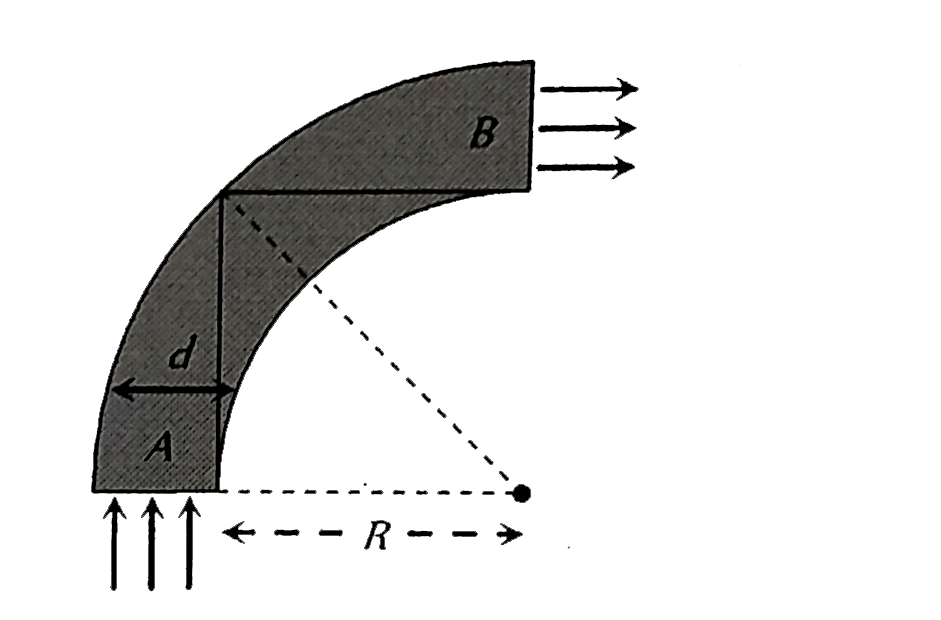A rod of glass (μ=1.5) and of square cross section is bent into the shape shown in the figure. A parallel beam of light falls on the plane flat surface A as shown in the figure. If d is the width of a side and R is the radius of circular arc then for what maximum value of dR light entering the glass slab through surface A emerges from the glass through B

1.5
0.5
1.3
None of these
The correct Answer is:B
Step by step video, text & image solution for A rod of glass ( mu = 1.5) and of square cross section is bent into the shape shown in the figure. A parallel beam of light falls on the plane flat surface A as shown in the figure. If d is the width of a side and R is the radius of circular arc then for what maximum value of (d)/(R) light entering the glass slab through surface A emerges from the glass through B by Physics experts to help you in doubts & scoring excellent marks in Class 12 exams.
Updated on:21/07/2023Topper's Solved these Questions
- RAY OPTICSBook:CENGAGE PHYSICSChapter:RAY OPTICSExercise:DPP 1.3
Explore 15 Videos
- RAY OPTICSBook:CENGAGE PHYSICSChapter:RAY OPTICSExercise:DPP 1.4
Explore 15 Videos
- RAY OPTICSBook:CENGAGE PHYSICSChapter:RAY OPTICSExercise:Matching Column Type
Explore 1 Video
- PHOTOELECTRIC EFFECTBook:CENGAGE PHYSICSChapter:PHOTOELECTRIC EFFECTExercise:Integer Type
Explore 4 Videos
- RAY OPTICS AND OPTICAL INSTRUMENTSBook:CENGAGE PHYSICSChapter:RAY OPTICS AND OPTICAL INSTRUMENTSExercise:QUESTION BANK
Explore 40 Videos
Similar Questions
A rod made of glass (μ=1.5) and of square cross-section is equal is bent into the shape shown in figure. A parallel beam of light falls perpendicurly on the plane flat surface . A . Referring to the diagram, d is the width of a side & R is radius of inner semicircle. find the maximum value of ratio dR so that all light entering the glass through surface A emerge from the glass through surface B.
_E01_133_Q01.png)
View SolutionA glass rod having square cross-section is bent into the shape as shown in the figure. The radius of the inner semi-circle is R and width of the rod is d. Find the minimum value of d/R so that the light that enters at A will emerge at B. Refractive index of glass is μ=1.5

View Solution
Knowledge Check
Rays of light fall on a glass slab (μgtl)as shown in the figure. If μ at A is maximum and at b it is minimum, then what will happen to these rays?
 Athey will tilt towards ABthey will tilt towards BCthey will not deviateDthere will be total internal reflection
Athey will tilt towards ABthey will tilt towards BCthey will not deviateDthere will be total internal reflectionRays of light fall on a glass slab (μ>1) as shwon in figure. If μ at A is maximum and at B it is minimum, then what will happen to these rays?
 AThey will tilt towards ABThey will tilt towards BCThey will not deviateDThere will be total internal reflection
AThey will tilt towards ABThey will tilt towards BCThey will not deviateDThere will be total internal reflectionLight falls obliquely on the surface of a thick glass slab as shown in the figure. Which statement among the following is correct
 ALight stops at the surface.BLight reflects at the surface but does not refract.CLight refracts at the does not reflectDA part of the light reflects at the surface and a part of it refracts.
ALight stops at the surface.BLight reflects at the surface but does not refract.CLight refracts at the does not reflectDA part of the light reflects at the surface and a part of it refracts.
A narrow parallel beam of light falls on a glass sphere of radius R and refractive index μ at normal incidence. The distance of the image from the outer edge is given by-
View SolutionA portion of a straight glass rod of diameter 2 cm and refractive index 1.5 is bent into an arc of a circle of radius R cm and a parallel beam of light is incident on it as shown in figure. Find the smallest R which permits all the light to pass around the arc.

View SolutionRays of light fall perpendicularly on a glass slab (n>1) as shown in figure. If n at A is maximum and n at B is minimum, then the rays will

View SolutionA long current wire is bent in the shapes shown in figure. The circular portion has radius R. The magnetic induction at the center of the circular segment is

View SolutionA ray of light is incident on a parallel-sided glass slab as shown in the figure. The angle of refraction for this ray of light is likely to be :

View Solution

